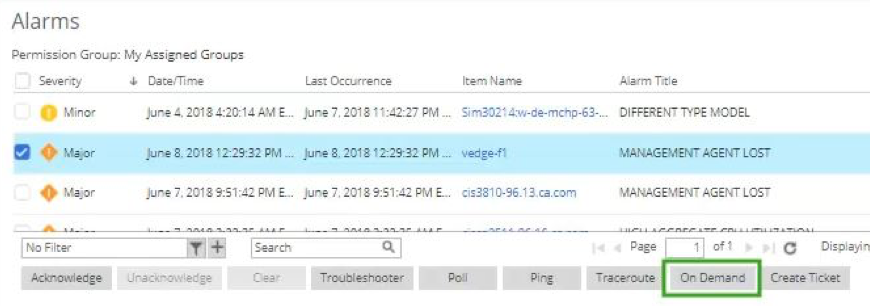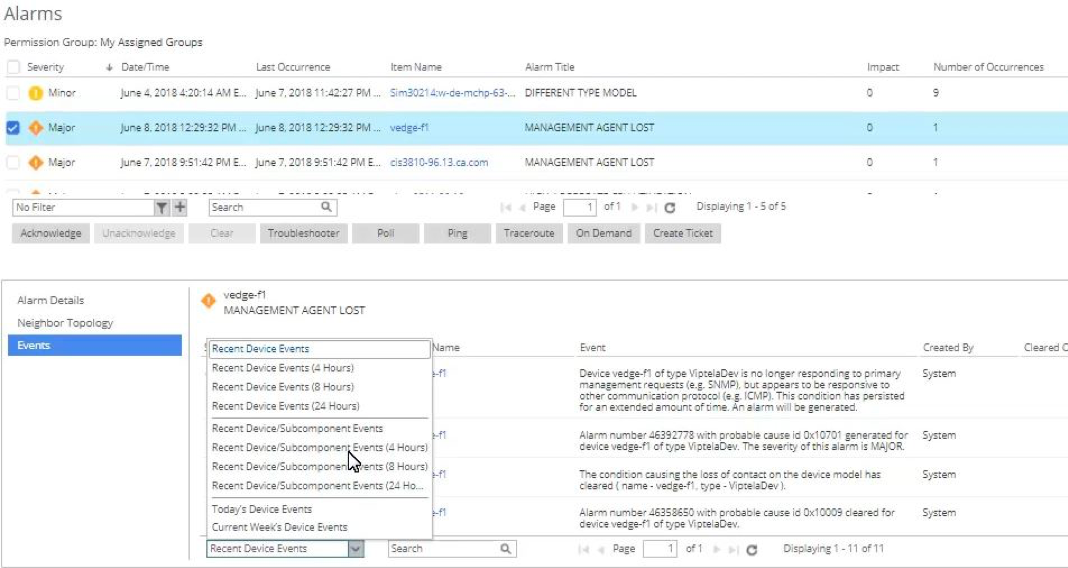In CA Spectrum, the viewing of alarms in OneClick is central to most operational workflows. OneClick alarm views enable you to identify the most impactful problems by presenting a prioritized list of alarms and facilitates network tools troubleshooting by correlating related alarms on the same device or neighboring devices.
CA Performance Management offers many customizable controls for the NetOps Alarms View to provide an effective and clutter-free UI. The Details section of the view provides a contemporary and efficient layout, where you can control which panels appear in the section including an Events panel.
The height of the alarm grid can be customized which controls the number of visible alarms. In addition, the alarm grid offers an expanded list of over 20 attributes to choose from when adding or removing columns or when sorting.
These features improve the user experience by allowing the network tools UI to adapt to individual users based on their needs within an Operations team.
Alarm Modification & Triage Actions
The Alarms View in the NetOps portal within CA Performance Management is not just limited to listing alarm and device information. It is fully actionable like the alarms view in CA Spectrum and can perform two categories of operations: alarm modification and alarm triaging.
The NetOps Alarm View allows direct access to device, component and performance data through in-context launches. Hyperlinks in the alarm grid enable navigation from an alarmed item to its context pages ensuring that the details you need are only a single click away.

In addition, the set of triage action buttons which included poll, ping and trace-route has been expanded to include a new button to launch a contextual on-demand report.

These reports can be launched from one or more selected items in the alarm grid and allow the selection of multiple metrics across one or more metric families. This ability to quickly access network tools performance data from alarms streamlines problem triage and is an important tool when troubleshooting issues such as threshold alarms on CPU or interface utilization.
Filter Creation
CA Performance Management provides the ability to easily create and use custom alarm filters. CA Spectrum has long offered powerful alarm filtering which is critical and central to its troubleshooting workflow. With this new feature, CA Performance Management offers similar levels of flexibility and capability. Operations teams can create, edit and save alarm filters allowing team members to scope alarm data and narrow the focus to those alarms which are most important.

Teams can also use our network tools to edit existing filters. These filters offer comparison to multiple values using both AND and OR operations, nesting of multiple conditions, Hide and Show capability based on attribute value, and full support of various attribute types.

Filter Management
Alarm filters are important to help members of an Operations team both identify and remediate problems efficiently and quickly. It is vital to have strong network tools features to control their use and availability.
When saving a filter, the user has the option to restrict the alarm for personal use, to make the alarm available to other team members with the same role, to all other users within the tenant or to specific users or roles.

In addition, separate role rights exist for both the creation and management of alarm filters. The use of roles when applying filter permissions enables users to be dynamically and automatically granted filter access while granular, individual user application can ensure that each team member has the right access.
Sharing the same filter or set of filters among team members promotes best practices by ensuring that alarms are viewed though the same selective lens so that only those alarms applicable to the team’s responsibility are spotlighted.
Attribute Extensibility
CA Spectrum has thousands of attributes out-of-the-box. To avoid the information overload that would result if CA Performance Management were to present all of these, our network tools select a set of the most used and applicable ones for alarm viewing, sorting, and filtering. There is an extensible mechanism to expand the list of available attributes as needed to efficiently process and accurately triage alarms. The management of alarm attributes is performed by REST calls and can be scoped at the tenant level or globally. This ability to add attributes ensures that you can capitalize on the full set of attributes in CA Performance Management that you leverage in CA Spectrum.

Event Visibility and Exporting
CA Performance Management provides the ability to view the events on a device by selecting an entry in the alarm grid. This is crucial to gain visibility into the timing and repetition characteristics of an alarm or into the causes of why an alarm has occurred or has been cleared.
Events are listed in the new Events panel which resides in the Details section of the NetOps Alarm View. These events include events that are sourced from CA Spectrum.
The events panel search option provides several selections to control both the scope and timeframe of listed events including options to see only those events directly on a device or events on a device and all its subcomponents. This latter option is often used to view the events on a network device and all its interfaces.

Each selection in this dropdown supports detailed hover-over tips that clearly describe its effect. This timeframe and subcomponent scoping functionality can be invaluable when troubleshooting the performance of a device.
In addition, as with other tables in CA Performance Center, you can further filter the listed events using the standard search field below the table.
Finally, the Events panel supports CSV data export for consumption by a 3rd party application just as the entire NetOps Alarm View can be exported in either CSV or PDF format to facilitate trouble ticket processing.
Move Away from Swivel Chair Monitoring
At CA, we truly believe a convergence of network tools is well overdue. Because of rapid advances in networking technology coupled with today’s consumer demands, NetOps will find themselves overwhelmed with way too many monitoring tools and way too little visibility into network health.
The advantage to the CA network fault and performance convergence is the ability to move away from multiple operational consoles driving simplicity in your ability to correlate different types of data and events. The ability to drive unified fault and performance workflows when triaging availability or service degradation in a single dashboard will no doubt improve operational efficiency and help to support a better experience within your network.

Co-authored by Jim Gordon: After obtaining his degrees in Computer Science, Jim went on to a career in software development; designing and implementing firmware for such varied products as intelligent building controllers, cutting-edge Ethernet routers and professional 2-way mobile radios. He joined the CA Technology family in 2005 where he traded in his software hat for one in educational development. LinkedIn: https://www.linkedin.com/in/jim-gordon-a55519/
Check out the NetOps Alarm Views Product Documentation here.
...And our 'How-To' video on integrating Alarm Views here.